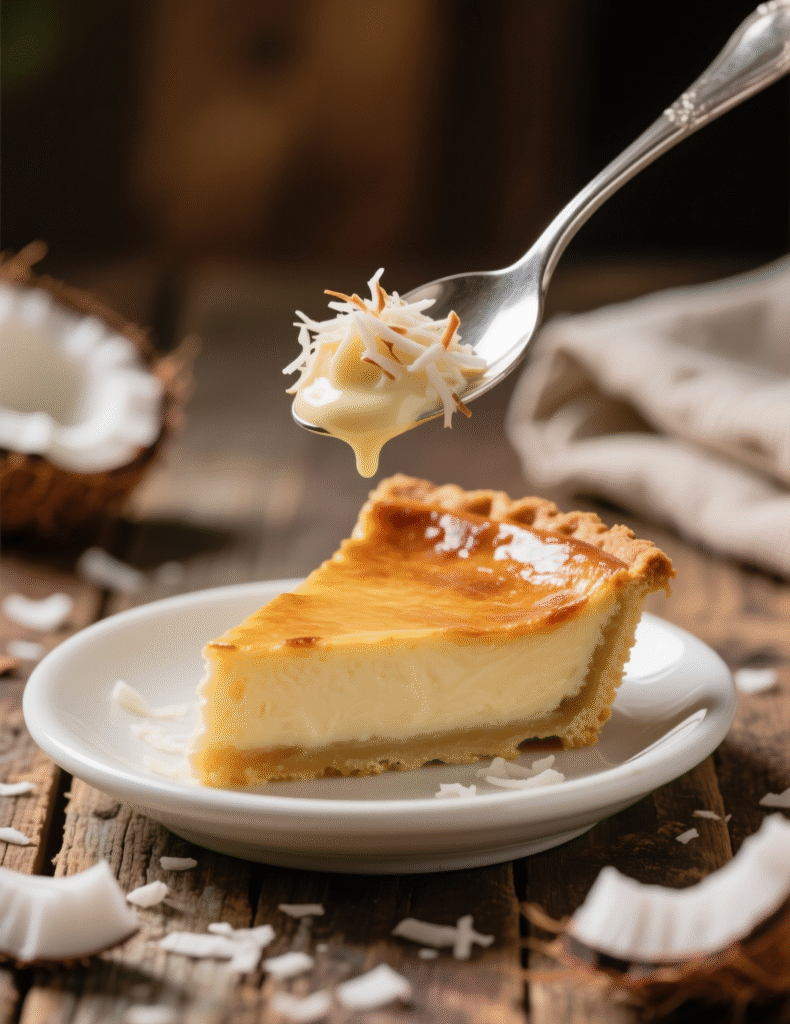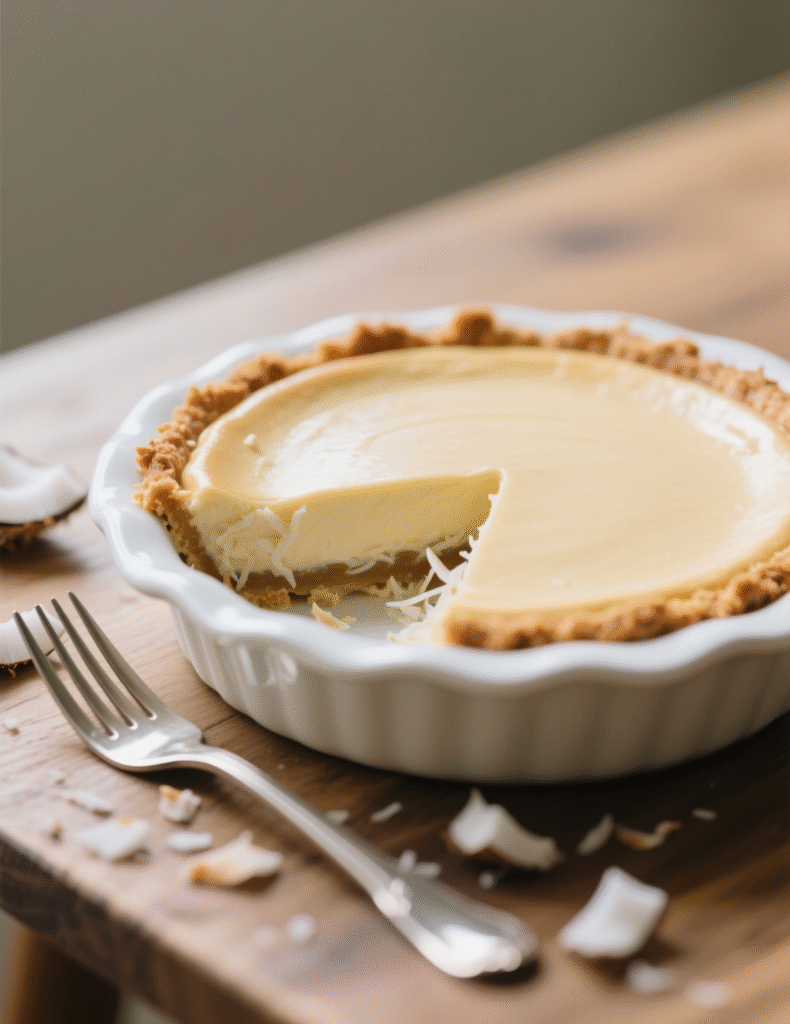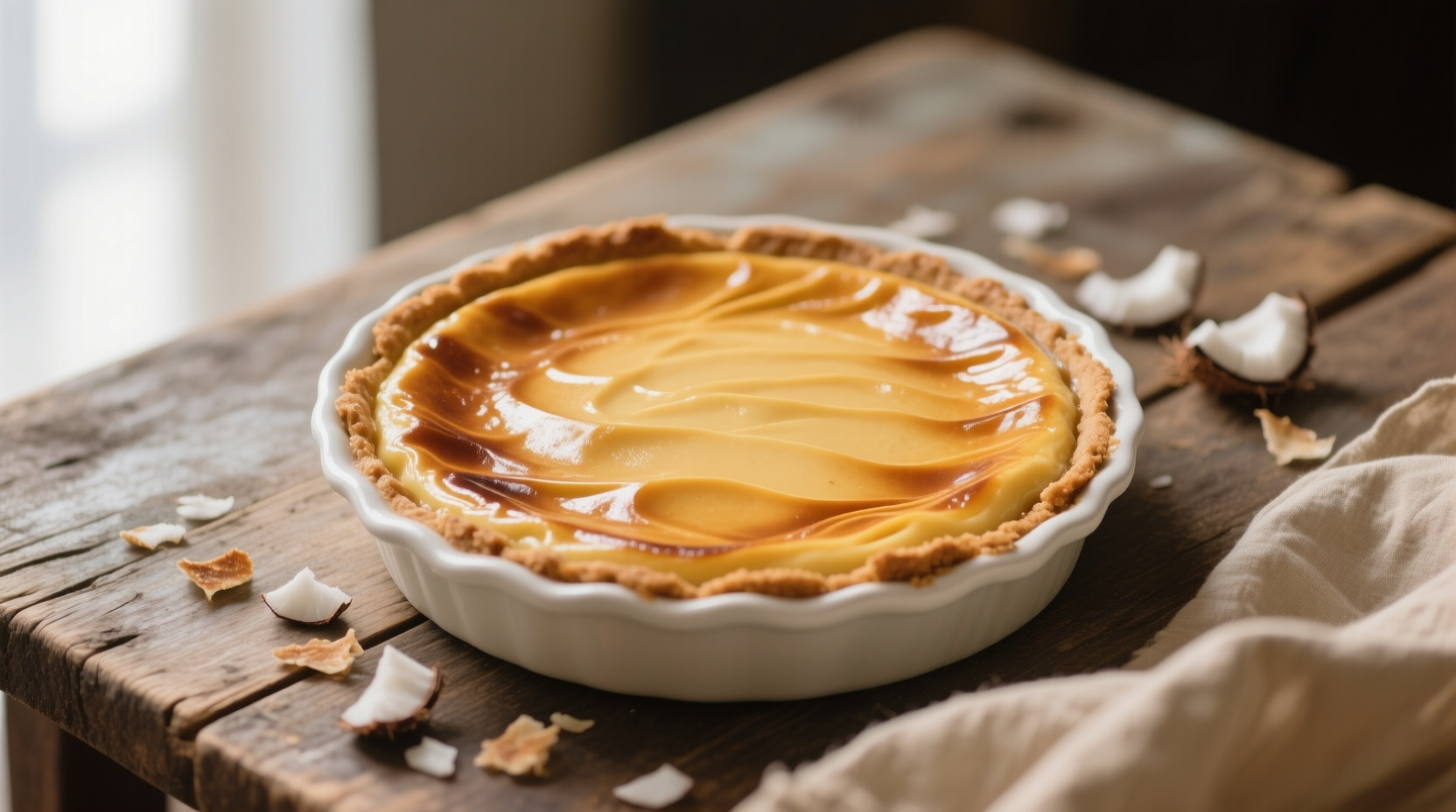If there’s one dessert that manages to taste like a memory and yet look entirely new, it’s the crustless coconut pie. Many people ask, why crustless? Isn’t the crust what makes a pie? Truth is, no—it’s the filling that tells the real story, and this pie proves it. This recipe has been whispered around southern kitchens, church potlucks, and chef roundtables, and for good reason—it delivers flavor with no fuss.
The Curious Charm of Going Crustless
Professional pastry chefs sometimes roll their eyes when someone mentions a crustless pie. They’ll say, “isn’t that just a custard?” Well, technically, no. A crustless coconut pie develops its own natural structure while baking. The edges caramelize just enough to mimic a thin crust, while the center stays velvety smooth. It is dessert engineering, but one that feels more like an accident than science.
Historically, coconut pies found their fame in the American South around the 19th century, when dried coconut began to be imported in large quantities. What made this pie unique was the fact that coconut added both flavor and texture, acting as a kind of built-in stabilizer. This is why you don’t need the buttery shell. The coconut provides the structure. Think of it as an edible scaffolding.
Ingredients That Make the Pie Sing
A typical crustless coconut pie recipe looks straightforward, almost too simple. Eggs, milk, sugar, butter, vanilla, flour, and of course—coconut. Yet, simplicity can often disguise genius. Let’s break it down from a professional’s lens:
- Eggs – not just binders here, but emulsifiers. They trap air, give lift, and form that custardy base.
- Butter – provides fat, richness, and that subtle nutty finish when it browns against the coconut edges.
- Milk – most recipes lean on whole milk, but pros sometimes mix half-and-half or even evaporated milk for depth.
- Flour – it looks like a small player, but this tablespoon or two ensures the custard sets with structure.
- Coconut – shredded, sweetened or unsweetened depending on preference. Each type affects sugar balance and moisture.
Many home cooks underestimate the type of coconut. Sweetened flakes will give you a pie that borders on candy, while unsweetened will taste more restrained, letting vanilla and butter shine. A pro will usually blend both, striking balance.
Technique Is Everything
You can hand someone the ingredient list, but unless they understand the technique, they’ll never get that bakery-level slice. Mixing order matters. Professionals will always cream the butter and sugar lightly before folding in eggs. This step ensures a smoother custard and prevents curdling during baking.
Baking temperature is another big trap. Too hot, and the edges scorch while the center stays soupy. Too low, and the pie never sets, turning rubbery instead of creamy. The sweet spot? Around 350°F (175°C), with the rack in the lower third of the oven. This positioning lets heat surround the custard evenly without overcooking the top.
One professional trick: let the mixture rest for 5 minutes before pouring into the dish. This allows flour to hydrate slightly, which prevents separation in the oven. You’ll notice a finer crumb-like texture once it sets.
The Science Behind the Magic
People sometimes call this pie “impossible pie.” That’s because during baking, it naturally separates into layers—slightly firm bottom, custardy middle, coconut-crusted top. How does that happen? It’s about density shifts. As the custard bakes, heavier flour and egg proteins sink slightly, while lighter fats and coconut rise. What you get is a self-layered dessert without lifting a finger.
In 2018, a culinary research project out of The Journal of Food Science highlighted how shredded coconut alters the crystallization of sugars during baking. Simply put, coconut interferes with sugar molecules binding too tightly, which helps maintain that luscious creaminess. That’s why this pie never feels cloying, even when it’s sweet.

Professional Variations
Chefs rarely stop at the classic recipe. They push it, stretch it, sometimes even risk ruining it just to see where it bends. Here are a few variations tested in professional kitchens:
- Tropical Twist: add crushed pineapple or mango puree for moisture and acidity. Balances the richness beautifully.
- Chocolate Coconut Custard: whisk in two ounces of melted dark chocolate. Coconut loves bitter notes.
- Nutty Edge: sprinkle toasted almonds or macadamias across the top before baking for crunch.
- Coconut Cream Liqueur: a splash of Malibu or coconut rum folds into the custard, making it adults-only dessert heaven.
Interestingly, some Michelin-level pastry chefs treat this pie almost like a canvas. They plate it with passionfruit coulis, candied lime zest, or black sesame tuile. Suddenly, the humble pie wears a tuxedo.
Common Mistakes and How to Dodge Them
Professionals often notice that home bakers repeat the same errors. One big mistake? Overbeating the eggs. You don’t want foam here, just incorporation. Foam equals air pockets, which collapse, leaving cracks.
Another error is using low-fat milk. It seems “healthier,” but what you get is watery custard that never fully sets. Fat is structure. Take it away, and the whole thing wobbles like an undercooked omelet.
Storage also gets overlooked. Many people toss it uncovered in the fridge, where it picks up odors from last night’s garlic roast. Always wrap tightly or store in airtight glass. Coconut is absorbent, almost like a sponge, and it will ruin your flavor profile overnight.
Who Really Eats This Pie?
You’d be surprised how often this recipe appears on menus. Not just diners, but also farm-to-table restaurants that highlight “heritage desserts.” One Texas chef I spoke to in 2021 said, “I keep it on the menu because people order it for the nostalgia, then come back for the texture.” Nostalgia sells, but texture seals the deal.
Even professional catering companies love it. Why? It holds up well on buffets, unlike delicate soufflés or mousses that collapse. Slices retain shape even after hours. That stability is worth its weight in butter.
A Nutritional Snapshot
From a health perspective, this pie isn’t exactly kale salad. A slice averages about 320 calories, depending on sugar and coconut type. Roughly 18 grams of fat, 30 grams of carbs, and 4–6 grams of protein per serving.
However, coconut brings medium-chain triglycerides (MCTs), which metabolize differently from long-chain fats. Studies from Harvard T.H. Chan School of Public Health suggest MCTs may provide quicker energy release. Not a license to eat half the pie, but a small slice feels less indulgent than, say, pecan pie drowning in corn syrup.
Pairings and Service Suggestions
Professionals never serve dessert naked. A crustless coconut pie begs for contrast. Whipped cream balances texture, while tart fruit like raspberries cuts sweetness. Some chefs plate it with espresso reduction, because coffee and coconut sing together.
Temperature also matters. Warm slices taste more custardy, while chilled slices lean toward firm pudding. Many fine dining restaurants serve it slightly cool, topped with crème fraîche for a tangy edge.
For wine pairings, consider a late harvest Riesling or a Muscat. Both bring fruitiness that echoes coconut without overwhelming it. Avoid overly oaked Chardonnays—they compete rather than complement.

Emerging Trends with Coconut Desserts
The demand for dairy-free or gluten-free desserts has put coconut in the spotlight again. Some chefs adapt the recipe with coconut milk instead of dairy. When done right, the result is surprisingly close in texture. Gluten-free flour blends also swap seamlessly, since flour plays such a minor role in the original recipe.
In 2024, market analysis showed a 12% rise in coconut-based desserts across US bakeries. Consumer demand leans toward “clean ingredients” and nostalgia desserts. The crustless coconut pie ticks both boxes—no artificial stabilizers, just eggs and coconut doing their thing.
Final Thoughts: Why This Pie Still Matters
A crustless coconut pie isn’t just another dessert. It’s proof that simple ingredients, handled with respect, can create magic. Professionals admire it not because it’s flashy, but because it delivers consistency, nostalgia, and versatility.
If you’re a chef, consider it for your menu. If you’re a home baker, try it for your family. Either way, it’s a dessert that requires very little but gives back more than expected. That’s the definition of good cooking.
And perhaps that’s why this pie endures. It’s not about crust or no crust. It’s about flavor that speaks for itself, no shell required.
FAQs
What is a crustless coconut pie?
It’s a custard-like dessert that forms its own layers while baking, no traditional crust needed.
Why does the pie separate into layers?
The density of ingredients causes natural separation, giving a firm base, creamy middle, and coconut top.
Can I use coconut milk instead of regular milk?
Yes, coconut milk works well and adds a deeper coconut flavor, especially for dairy-free diets.
Should I use sweetened or unsweetened coconut?
Either works, but professionals often blend both for balance in sweetness and texture.
Why did my pie crack on top?
Overbeating eggs or baking at too high a temperature usually causes cracks.
Can this pie be made gluten-free?
Yes, just replace the flour with a gluten-free blend since only a small amount is used.
How long does crustless coconut pie last?
It keeps 3–4 days in the fridge when wrapped tightly or stored in an airtight container.
Is this dessert healthy?
It’s indulgent, but coconut provides MCT fats that digest differently and give quick energy.
Can I freeze crustless coconut pie?
Yes, freeze slices tightly wrapped, then thaw in the fridge for best texture.
What’s the best way to serve it?
Slightly chilled with whipped cream, fresh berries, or a drizzle of coffee sauce works beautifully.

Mariana is a passionate home cook who creates delicious, easy-to-follow recipes for busy people. From energizing breakfasts to satisfying dinners and indulgent desserts, her dishes are designed to fuel both your body and hustle.
When she’s not in the kitchen, she’s exploring new flavors and dreaming up her next recipe to share with the Foodie Hustle community.

